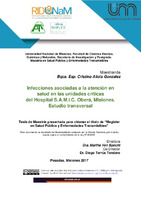Infecciones asociadas a la atención en salud en las unidades críticas del Hospital S.A.M.I.C. Oberá, Misiones. Estudio transversal
Abstract
Las acciones de vigilancia, constituyen el principal componente para la prevención y control de las infecciones asociadas a la atención en salud (IAAS).
Para este importante problema de Salud Pública, se estudió la magnitud, distribución, etiología y perfil de resistencia a los antimicrobianos en las unidades críticas.
Se aplicó, el protocolo del Proyecto EPINE (Estudio de Prevalencia de Infecciones Nosocomiales en España), en los años 2015-2016, por primera vez en un Hospital nivel III del Interior, de la provincia de Misiones, donde no existe un programa estructurado en esta área.
La prevalencia de IAAS, detectada en las unidades de cuidados intensivos de adultos (UTI), fue de
24.47% y en la de neonatología (UCIN), de 18.58%.
Entre los factores de riesgos intrínsecos, la diabetes mellitus (p=0,03), y la hipoalbuminemia (p=0.02), se asociaron de forma significativa, con la presencia de IAAS en UTI, y la inmunodeficiencia (p= 0.01) y coma (p=0.03), en UCIN.
Entre los factores de riesgos extrínsecos, la asistencia respiratoria mecánica (ARM) (p= 0.01), se asoció de forma significativa, con la presencia de IAAS en UTI, y el catéter venoso central (p=0.001) y ARM (p=0.02) en UCIN.
El principal patógeno causante de la infección, en UCIN, fue Klebsiella pneumoniae, con 100 %
resistencia, debidas a betalactamasas de espectro extendido (BLEE), y en UTI fue Staphylococcus aureus resistente a la meticilina adquiridos en la comunidad (SAMR-AC), 5(62%), y Staphylococcus aureus resistente a la meticilina adquiridos, en el hospital (SAMR-HA) 3 (37.5%).
Con la aplicación de la metodología EPINE, se logró establecer la comprensión de las IAAS, a
nivel local, lo que permitirá adecuar las medidas necesarias, para el control, y motivar al equipo
de salud, a proveer buenas prácticas de atención al paciente. Surveillance actions, are the main component for the prevention and control, of health care-associated infections (HCAI). For this important public health problem, the magnitude, distribution, etiology and profile of antimicrobial resistance, in critical units were studied.
The protocol of the SNIPS Project (Study of Nosocomial Infection Prevalence in Spain), was applied in the years 2015-2016, for the first time in Hospital Level III, of the interior of the province of Misiones, where there is no structured program, in this area.
The prevalence of HCAI detected in the intensive care units of adults (ICU), was 24.47% and in neonatal care units (NICU) of 18.58%.
Among the intrinsic risk factors, diabetes mellitus (p=0.036) and hypoalbuminemia (0.0204) were significantly associated with the presence of IAAS, in ICU, and immunodeficiency (p=0.0139) and coma (p=0.0337) in NICU.
Among the extrinsic risk factors, mechanical ventilation (MV) (p=.011), was significantly associated with the presence of HCAI, in the ICU, and the central venous catheter (p=0.0014) and MV (p=0.0241) in the NICU.
The main pathogen causing the infection in NICU, was Klebsiella pneumoniae, with 100% resistance due to extended-spectrum beta-lactamases (ESBL), and in ICU was methicillin-resistant Staphylococcus aureus acquired in the hospital (SAMR-HA) 3 (37.5%), Methicillin resistant Staphylococcus aureus acquired in the community (SAMR-AC) 5 (62%).
With the application of the SNIPS methodology, it was possible to establish, the understanding of the HCAI, at the local level, which will allow adapting the necessary measures for the control, and motivating the health team to provide good practices, of patient care.
Collections
- Maestría [30]
The following license files are associated with this item:




